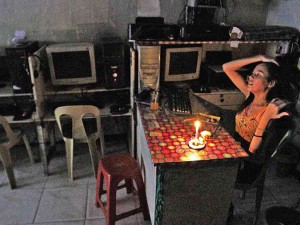
Nine business groups have urged the Aquino administration to define and craft a clear-cut program that would ensure the security of power supply and stability of electricity rates in the country. RAFFY LERMA
MANILA, Philippines—Nine business groups have urged the Aquino administration to define and craft a clear-cut program that would ensure the security of power supply and stability of electricity rates in the country.
The country’s energy situation is deemed a key, critical factor in realizing the government’s overarching goal to accelerate the industrial sector and ensure a more sustainable, inclusive growth.
A joint position paper was submitted to President Aquino late last month by the Philippine Chamber of Commerce and Industry (PCCI), Alyansa Agrikultura, Chamber of Mines of the Philippines (COMP), Employers Confederation of the Philippines (Ecop), Philippine Exporters Confederation (Philexport), Semiconductor and Electronics Industries of the Philippines (Seipi), American Chamber of Commerce of the Philippines (AmCham), European Chamber of Commerce of the Philippines (ECCP) and the Korean Chamber of Commerce of the Philippines (KCCP).
In the position paper, the Philippine business groups and the foreign chambers said they were more than ready to support measures that would resolve the country’s power situation, but stressed the need for the national leadership to define the national policy concerning supply sustainability and reliability, and regional competitive power tariff.
One of the mid-term recommendations put forward by the business groups was the creation of a market for long-term contracts.
“We propose requiring distribution utilities to contract 100 percent of their forecast energy requirements for the next three years and no less than 90 percent for seven years thereafter. These requirements should then be subjected to competitive public auctions,” the groups explained.
“This policy can create a market for long-term contracts that provide incentives for investment in the generation sector and offer greater protection for consumers from exposure to spot market volatility. Without long-term contracts, investors will be less willing to build new capacity in a small and undeveloped merchant market,” they added.
The business community has also called for the creation of a “Forward Market,” wherein the the Energy Regulatory Commission (ERC), together with the generators and DUs, would develop a standard template for forward contracts and rules governing procurement.
Also needed was an “Ancillary Services (Reserve) Market,” which the groups stressed was vital in ensuring the power quality and service reliability required by commercial and industrial users.
“We recommend that we require National Grid Corporation of the Philippines (NGCP) to secure firm contracts for ancillary services; for the ERC to monitor the NGCP’s compliance; and for the Department of Energy (DOE) to set the parameters delineating a role for National Transmission Corp. in the determination of the levels of ancillary services,” they said.
Long-term proposals include the crafting of a national power supply road map specifying, among others, the required power plants, their configurations (fuel type, size, etc.), locations and schedule of operations, and developing programs and processes that ensure fair and transparent competition among stakeholders in the supply side.
The nine business groups also wanted closer coordination among economic, fiscal, industrial and energy sectors to develop a competitive tariff sweet spot, and the development of a strong public-private coordinating task force to provide leadership in promoting the program and overcoming anxiety or resistance from LGUs and civil sectors when it comes to power projects.
Currently, Luzon needs 600 megawatts of additional capacity to serve the requirements of its residents and another 300 MW yearly over the next several years. Visayas needs 150 MW and another 150 MW annually over the succeeding years, while Mindanao needs 300 MW and about 120 MW yearly thereafter to meet desired regional economic growth targets.